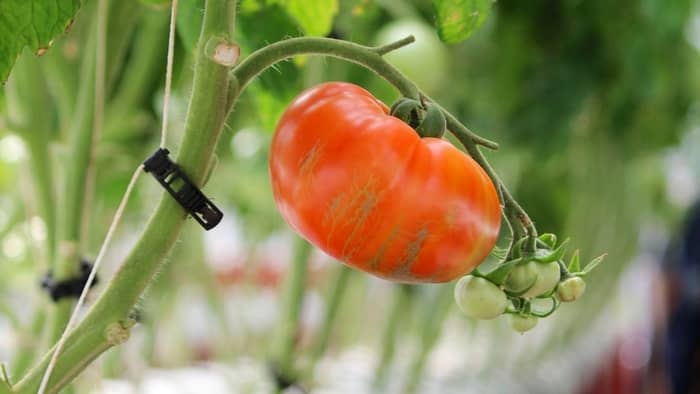Last Updated on March 26, 2022 by Marco C.
Oftentimes people wonder: why are my cherry tomatoes splitting? This unfortunate occurrence happens at the most inconvenient times.
If you have grown tomatoes before, you may have noticed this happening. Splitting is when a small crack starts to form down the side of your tomato. It happens when the tomato is large enough to harvest.
When you notice early enough, the tomatoes are still edible. However, if the split occurs over time funguses and insects will start to crawl inside the tomato. This makes all your hard work wasted.
In aquaponics, tomatoes are a popular fruit to grow. If you have a large operation, the last thing you want is to come to the garden one day and see a bunch of split tomatoes.
This article will answer the important question: why are my cherry tomatoes splitting? It will also overview key things that you can do to avoid this serious issue.
After you read the article, hopefully, your tomatoes will never split again! Keep reading now to get started on your tomato-growing journey!
Why Do Tomatoes Split?
The most important thing for you to understand is the reasons why your tomato splits. If you can understand the causes, then you can prevent it from happening.
There are different ranges and types of splits. Some are more severe than others. Splits can happen vertically, horizontally, or around the stem.
The cracking around the stem is considered the least serious one. Most importantly, be sure to observe your tomatoes every day. This will help you observe any problem as soon as it occurs.
Not all splits reveal the inside of the tomato. Sometimes the splitting happens only on the surface of the skin. In these cases, the inside of your tomato will not be affected.
Learn more about: Do Tomatoes Need To Be Pollinated In Aquaponics Systems? Read Now!
This is good news. However, it is possible for the crack to become bigger and expose the inside of the tomato. If you notice any sign of splitting, monitor the fruit on a daily basis to make sure the problem does not worsen.
But, why are my cherry tomatoes splitting? Well, a tomato splits when it is receiving uneven water. For example, in aquaponics, if you forget to turn on the water for a few days, then flood the beds.
This causes the fruit to develop in an inconsistent way. In this case, the inside of the tomato is growing faster than the skin, causing a split.
It is really important that once you see your tomatoes fruiting, keep your water cycles consistent. As soon as you see fruit forming, it is time for you to be vigilant.
Make sure you are providing a comfortable environment as well. If there is a lot of sun and it’s hot outside, you may need to water more during this time.
What Causes Tomatoes To Split?
As answered above, the top three reasons your tomato might split are uneven watering, poor drainage, and a lack of monitoring. If you do not watch your tomatoes, you have a higher risk of having a problem.
Establishing a proper water cycle is the best way to ensure juicy fruit at the end of its growing period. Usually, in aquaponics, the watering cycles operate on a timer. Make sure to check all your electrical connections to ensure that the pumps are working properly.
Sometimes if there is an electrical outage, your pumps will need to be reset to work correctly. When your tomatoes are fruiting, just be sure that everything is working smoothly. You do not want to have a problem with the harvest.
Make sure that your aquaponics bed has proper drainage. You can observe how the water flows out of your grow beds. If you notice that water is pooling at the surface, you may need to amend your soil.
Depending on your growing medium, you can add sand to help promote drainage. If you are using a medium like clay balls, you may need to simply move the balls around or clean them to get better drainage.
Try to make sure that your water is not splashing up onto the fruit or leaves of the plant. This can cause other issues like root rot or blight. Anything that will disturb your plant should be avoided.
Another good way to avoid tomato splitting is to harvest a little bit earlier than expected. If you see healthy, almost fully-ripe tomatoes on the vine, it is best to pick them. Let them continue to ripen off the vine.
This ensures that you have a healthy tomato. The longer you leave them on the vine, the more susceptible they are to a bug invasion of splitting.
We suggest picking the tomatoes when they are orange reddish or the first day you see them turning a strong red color. This takes discipline and consistent observation.
Overcoming Tomatoes Splitting
If you want to grow tomatoes in aquaponics, it can be a great business. According to the MDPI scientific journal, “Aquaponics is one of the most promising sustainable systems for food production that combines hydroponic systems with recirculating aquaculture systems.” Nowadays, water is becoming a scarce resource.
Growing tomatoes aquaponically can be a good solution to this issue. But of course, you do not want your tomatoes to split.
After reading this article, you can see it is not very hard to avoid tomatoes from splitting. Now you know the answer to: why are my cherry tomatoes splitting? With this knowledge, you should be able to grow tomatoes successfully.
Just make sure the tomatoes are being grown in a consistent environment. This means stable sunlight, drainage, water, and nutrients. When a tomato is in its fruiting stages, it is near the end of its life.
At this time, it is never a good idea to change the environment. Any changes will be very shocking to the plant.
As long as you follow this advice, you should not have any serious issues with tomato splitting. We are always happy to help you.
Feel free to comment and ask questions below!
FAQs
What causes tomatoes to split?
The top three reasons your tomato might split are uneven watering, poor drainage, and a lack of monitoring. If you do not watch you tomatoes, you have a higher risk of having a problem.
Establishing a proper water cycle is the best way to ensure juicy fruit at the end of its growing period.

Candace is an aquaponics expert with over 5 years of experience in the field. She has a degree in environmental science from the University of California, Berkeley and a degree in aquaponics from the University of Florida. She is passionate about sustainable agriculture and has a deep knowledge of aquaculture and hydroponics. She has worked on numerous projects and has been involved in the development of aquaponic systems and fish farms. She also has experience in designing and constructing aquaponic systems. With her expertise, Candace is able to advise clients on the most effective and efficient way to construct and manage their aquaponic system. She is an active member of the aquaponic community, often speaking at conferences and seminars. Candace is dedicated to helping others understand the importance of aquaponics, and she is a strong advocate for sustainable food production.

